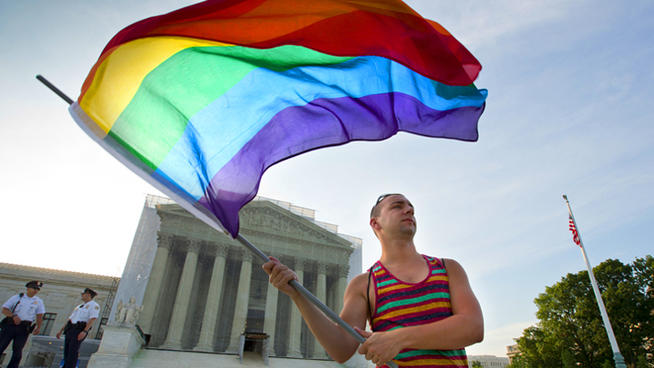There is certainly no shortage of Buzz material this week.
The Supreme Court ruled on several pivotal cases that will have far-reaching ramifications for diversity and inclusion.

THE WINNERS
Marriage Equality
We are jubilant that the Defense of Marriage Act (DOMA) was struck down, albeit in a narrow decision (5-4), so that now same-sex married couples in the 12 states that have marriage equality will be guaranteed federal benefits. In more good news for LGBT rights, the Supreme Court rejected the appeal of a lower court’s declaration that California’s Proposition 8 is unconstitutional. This means that gay marriage will likely soon once again be legal in California.
Affirmative Action in Higher Education
Relative to affirmative action in higher education, the Supreme Court essentially side-stepped the issue, sending the University of Texas at Austin case back to the lower courts. However, for now, it is somewhat of a victory for maintaining race as a factor in college admissions. In essence the court said the University of Texas may continue to use race as a factor in selecting some of its students, for now. However, the justices said that a lower federal court used the wrong standard to dismiss a challenge to the Texas system of affirmative action admissions. Troubling to me is the statement by Justice Anthony Kennedy, who wrote the opinion for the majority, saying lower courts may defer to a university’s judgment that student diversity provides educational benefits, but should strictly scrutinize any race-conscious methods they implement to attain it. Because racial classifications inherently are “odious to a free people”.
If racial classifications are “repulsive” to a free people, then at least in US society, we have many repulsive policies and practices including EEO-1 classifications and other labeling such as media accounts that use race to describe their subjects (“an Hispanic male or “the first African American women,etc.). The dissenters of affirmative action who want “color blind” policies to ensure fairness must consider the statistics and the realities that we do not live in a color blind world.
As I reported in my June 13 blog post, California, Texas and Florida already banned race based preferences in college admissions. Studies show that Asians have benefitted greatly from the ban. The enrollment of white students has declined in public universities in these states (maybe due to overall demographic changes), post the affirmative action ban. The largest negative impact has been for African American students. For example, prior to California’s Proposition 209, which outlawed affirmative action in college admissions, at UC Berkeley, the percent of African Americans in the student body declined from 6.5% in the mid-nineties to below 3% for the freshman class a decade later. While Hispanics are a larger portion of the populations of California, Texas and Florida, they too suffered declines in enrollment after the affirmative action ban.
THE LOSERS
Voting Rights Act of 1965
On Tuesday, the Supreme Court overturned a key part of the Voting Rights Act of 1965 — the map that determines which states must get federal permission before they change their voting laws.
A 5-4 decision by Chief Justice John Roberts, leaves the future of the law up to a sharply divided Congress to redraw the map.
The Voting Rights Act required nine states (mostly in the South but also 12 cities and 57 counties elsewhere) with a history of voting rights violations to get approval from the Justice Department or a special panel of judges before they change their voting laws.
While the law was renewed in 2006, the coverage map still uses election data from 1972 to determine who is covered. In making the ruling, Justice Roberts cited census data showing that black voter turnout now exceeds white turnout in five of the six states originally covered by the law. The court published a chart comparing white and black voter registration in 1965 and in 2004 in the six states originally covered. In Alabama, for example, the white registration rate was 69% and the black rate 19% in 1965. By 2004, that gap had all but disappeared — 74% for whites and 73% for blacks.
The truth is that the Voting Rights Act is invoked often. It was used to block more than 1,000 proposed changes to voting laws between 1982 and 2006. Just last year, the Voting Rights Act was invoked to stop a voter identification law in Texas and a Florida law that would have eliminated early voting days.
Employment Discrimination
It was not such good news for laws that protect workers from discrimination. Two cases decided by the Supreme Court this week make it harder for workers to prove employment discrimination.
In one case the term “supervisor” was more narrowly defined, and the other beefed up the standard for workers to prove that they had faced illegal retaliation for complaining about employment discrimination. In both cases, the rulings were decided by a 5-4 majority, with the liberal dissenting justices, asking Congress to reverse what they said were overly restrictive rulings.
In the first case, the majority decision, written by Justice Samuel A. Alito Jr., rejected the definition of “supervisor” used by the Equal Employment Opportunity Commission as someone authorized to “take tangible employment actions or direct the employee’s daily work activities”. The court ruled that only the first part of the definition, “take tangible employment actions”, should define a supervisor.
In a strong dissent, Justice Ruth Bader Ginsburg argued that the majority opinion “is blind to the realities of the workplace”. She wrote that it is not easy for an employee to tell a harassing supervisor to “buzz off” even when the supervisor does not have the power to fire or demote.
In a second employment decision the court restricted the legal standard for plaintiffs who claim that they faced adverse employment actions in retaliation for filing a discrimination complaint. The court held that the plaintiff must prove that the retaliation was the only motive in the action taken.
The majority decision, written by Justice Anthony M. Kennedy, said retaliation cases should have a different, tougher standard of proof than in regular employment discrimination cases under Title VII of the Civil Rights Act of 1964. Again Justice Ginsburg wrote a dissent saying the tougher “but-for causation standard” that the court was adopting for retaliation cases would undercut efforts to fight employment discrimination.
So disturbed by the high court’s decisions, Justice Ginsburg concluded that Monday’s two employment-related decisions “should prompt yet another Civil Rights Restoration Act”, a 1987 law that in effect overturned several Supreme Court rulings.
Conclusion
Two big steps forward for gay and lesbian rights, a stay on affirmative action in higher education and two big steps backwards for employment and voter discrimination.
Image credit: AP Photo/J. Scott Applewhite


















